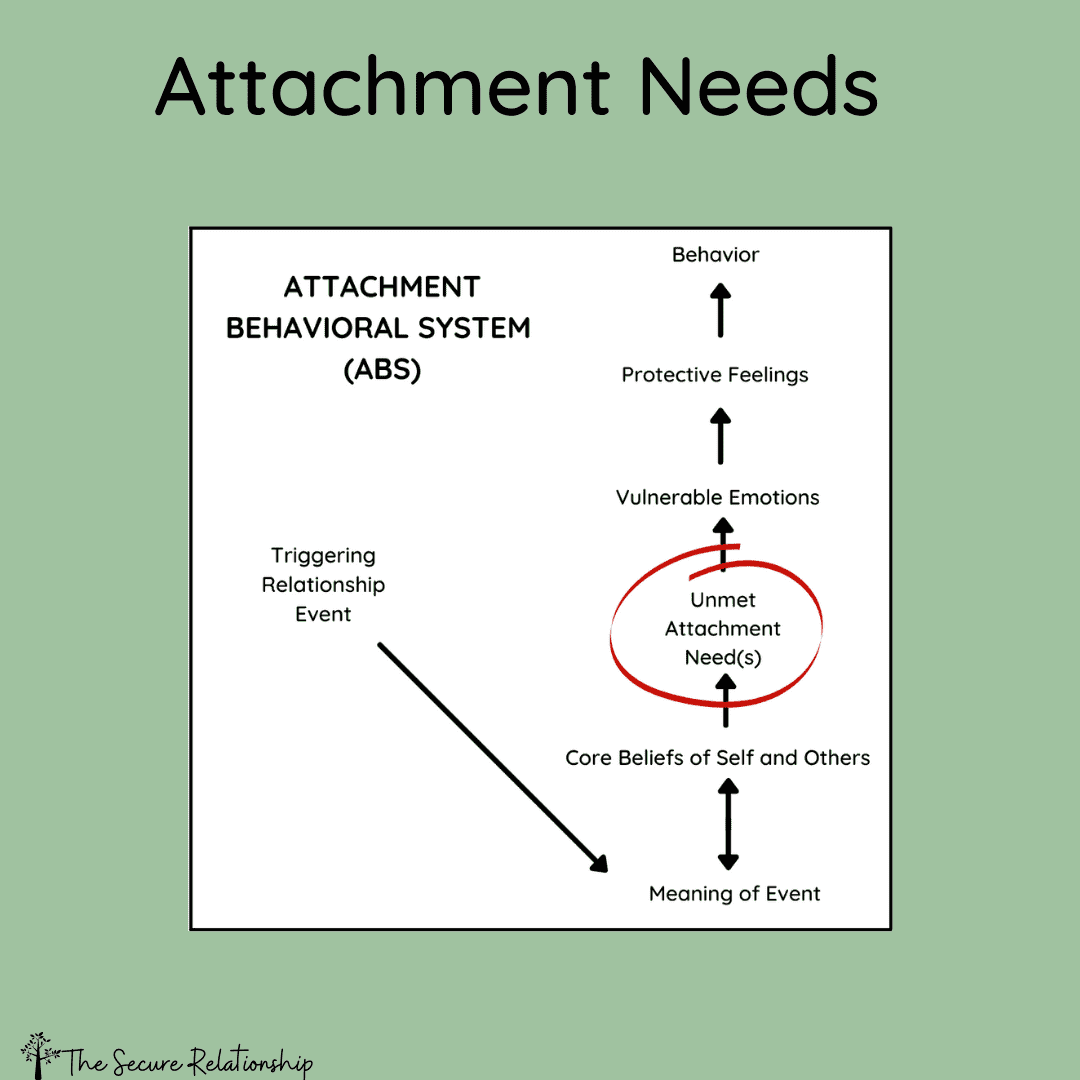Attachment Needs & Fears
Understanding What Creates Emotional Safety—and What Undermines It
All partners in attached relationships have attachment needs—whether or not they’re aware of those needs or able to put them into words.
When one or more of these needs go unmet, attachment security is threatened. This threat activates the attachment behavioral system (ABS)—also called an attachment trigger. Even if someone generally feels secure in their relationship, an unmet need in a single moment can create distress.
That distress will linger until the partner finds their way back to emotional safety.
Later in the Secure Love book, we’ll explore why these needs often go unmet. But first, it helps to understand what those needs actually are.
Common Attachment Needs
These are the most frequent human attachment needs that help partners feel safe and close to each other. Some are especially important to anxious partners, others to avoidant or disorganized partners. Securely attached individuals tend to have more balanced needs.
To feel valued and important to you
To know I’m not too much for you
To know you appreciate my strengths as a partner
To know my needs matter to you
To know you can hear, understand, and validate me
To know you want me
To know you view me as an equal partner
To know you respect me
To know you trust me
To know I can trust you
To know you’ll be there when I really need you
To know I can get it right for you
Needs from Self vs. Needs from Partner
Some people mistakenly believe that attachment needs should be met entirely by the self. While self-validation and self-respect are essential, they are not enough.
Feeling safe and close in a relationship requires that partners meet each other's needs too.
Otherwise, the alternative is disconnection—where partners don’t value each other, don’t want each other, don’t respect each other. In that dynamic, emotional safety simply isn’t possible.
Unmet Needs: Real or Perceived?
Sometimes a need truly goes unmet. Other times, it may feel unmet even if it isn’t—especially if someone is carrying past relational trauma or misinterpreting a partner’s actions.
For example, a partner might believe the other is untrustworthy, even if there’s no current evidence. Often this belief stems from past experiences—sometimes from childhood—being projected onto the relationship.
Avoidant partners especially struggle with expressing needs clearly. If one shuts down during conflict, it may be an attempt to protect the relationship—yet it sends the message:
“I don’t care about you or this relationship.”
Even when the intention is connection, the impact can feel like abandonment.
Attachment Ruptures
When an attachment need goes unmet (or is perceived as unmet), it creates what’s called an attachment rupture. This activates the ABS and causes disconnection.
All couples experience attachment ruptures. The key difference between secure and insecure couples is whether and how quickly they can repair them.
Secure couples: Repair quickly and return to emotional closeness.
Distressed couples: Accumulate ruptures over time until the overall relationship feels unsafe.
Climate vs. Weather
Think of your relationship like the weather.
Even in a warm, sunny place like San Diego, you’ll get occasional storms. Those storms are like temporary attachment ruptures—moments of unmet needs.
But if storms happen frequently and without repair, the overall climate shifts. What was once a secure relationship becomes one marked by persistent disconnection.
The goal is to build a climate of emotional safety, where storms are rare and manageable—not the norm.
Attachment Fears
Attachment fears are the flip side of attachment needs.
They’re rooted in the belief that a partner won’t meet those needs in the future. If someone grew up without having their needs met—or had past relationships where they felt abandoned—those fears tend to show up even in safe relationships.
Sometimes the fear is so strong it overrides what’s actually happening. Even when their partner is showing up, they may struggle to receive it.
Reflection Questions (from Secure Love)
What attachment needs do you most relate to?
Which of those needs went unmet in your childhood?
Which are being met in your current relationship?
Which needs are going unmet right now—some or all of the time?
Related Resources
Secure Love Book
– Learn the core concepts of attachment needs, fears, and emotional repair directly from Julie’s bestselling guide to creating secure relationships.
Attachment 101 Course
– Learn how your attachment style shapes the way you experience and express needs in relationships
Understanding Shame Workshop
– Explore how shame blocks the ability to communicate needs and receive love
Relationship Coaching
– Work with a coach to better understand, express, and meet attachment needs in your relationship
The Secure Love Podcast
– Listen to real couples navigate unmet needs and emotional repairs in real time
“Attachment needs and attachment fears are two sides of the same coin.”



Emotional blocks are not the problem in relationships. The problem is not knowing how to talk about them. Learn how couples can discuss their protective patterns with curiosity, vulnerability, and emotional safety to build a more secure relationship.